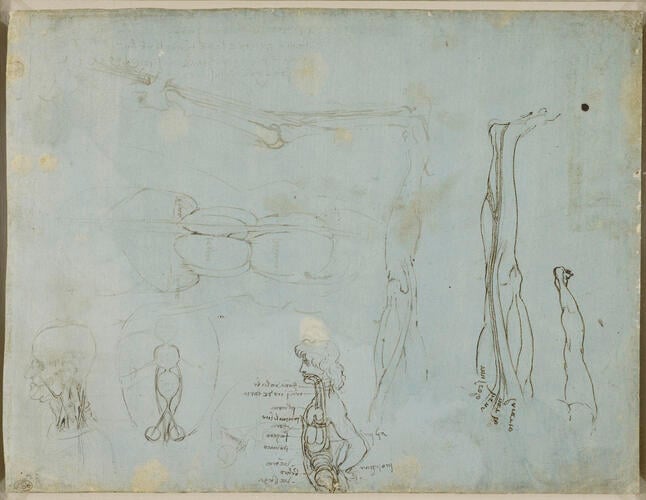-
1 of 253523 objects
Recto: Miscellaneous anatomical studies. Verso: The leg sectioned c.1485-90
Recto: Pen and ink over metalpoint, on pale blue prepared paper. Verso: Pen and ink | 22.2 x 29.0 cm (sheet of paper) | RCIN 912627

Leonardo da Vinci (1452-1519)
Recto: Miscellaneous anatomical studies. Verso: The leg sectioned c.1485-90

Leonardo da Vinci (1452-1519)
Recto: Miscellaneous anatomical studies. Verso: The leg sectioned c.1485-90



-
Recto: three studies of legs; one is seen from behind; one is in profile, drawn to show the muscles, veins and nerves, the third is shown from the front, with the muscles indicated; a young man in profile to the left, drawn to show the digestive organs; to the left, a head in profile showing muscles and bones; a section of a skull; the bones of the leg; a frontal view of the digestive organs.
Verso: the right leg of a man, measured, then cut into sections, which show the parts of his anatomy letterd for reference. Using Leonardo's lettering: surrounding the femur (with its marrow), d, are vastus medialis (a), the adductor muscles (b and c), vastus lateralis (e), the short and long heads of biceps femoris at (f and n respectively), and semimembranosus and semitendinosus merged (g). Rectus femoris and sartorius are probably the unlabelled muscles to the front of the femur; gracilis is not indicated.
Cross-sectional anatomy is commonplace today, in computed axial tomography (CAT) and magnetic resonance imaging (MRI), but Leonardo’s use of this representational technique for the human body was unprecedented. Here, most of the larger muscles of the upper leg can be identified in position, suggesting that Leonardo did indeed section a human leg in this manner – it would not be possible to infer this arrangement from surface examination, or from animal material. The lack of fixatives (or freezing) to harden the tissues such that they could easily be sawn into discs must have hampered him – soft, unfixed tissue tends simply to fall apart when cut, and the relative sizes and positions of the muscles here are thus not entirely correct, but the detail to the left still bears comparison with an equivalent modern image.
The letters .D.D are inscribed in black ink, in the hand of Leonardo's assistant Francesco Melzi.
Text adapted from M. Clayton and R. Philo, Leonardo da Vinci: Anatomist, London 2012, no. 6Provenance
Bequeathed to Francesco Melzi; from whose heirs purchased by Pompeo Leoni, c.1582-90; Thomas Howard, 14th Earl of Arundel, by 1630; Probably acquired by Charles II; Royal Collection by 1690
-
Creator(s)
Acquirer(s)
-
Medium and techniques
Recto: Pen and ink over metalpoint, on pale blue prepared paper. Verso: Pen and ink
Measurements
22.2 x 29.0 cm (sheet of paper)
Other number(s)